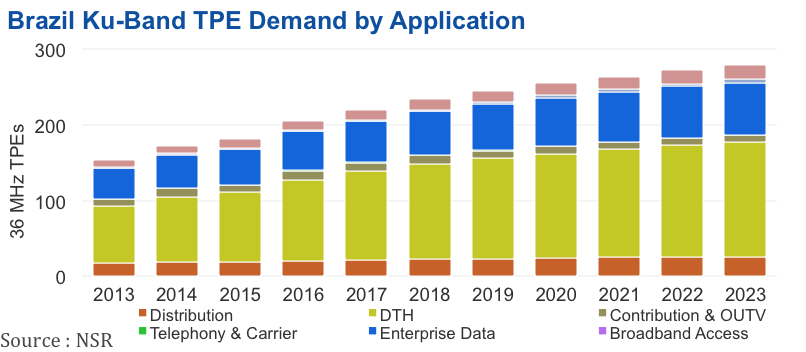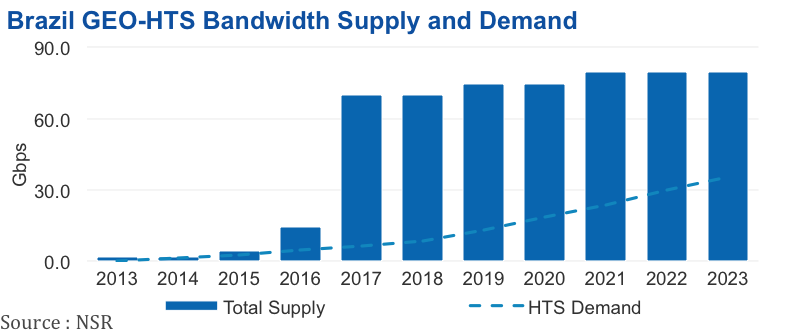Braving the Amazon—Entering the Brazilian Market
Dec 17th, 2014 by
Blaine Curcio, NSR
Of the 5 BRICS economies, the one making the most
noise in the satellite telecom sphere recently is
Brazil. Indeed, it seems as though not a month goes by
without the announcement of more capacity coming online
or another big contract signed. This has led to
questions of a capacity bubble, and whether there will
be sufficient demand to soak up the staggering amount of
capacity coming online. NSR’s BRICS Satellite
Capacity Supply & Demand study highlights a number
of potential issues and opportunities within each of the
BRICS economies, with Brazil providing some of the most
intriguing storylines.
FSS Analysis
There are several factors to consider in the
Brazilian market on the traditional FSS side. The most
widely utilized frequency within Brazil, Ku-band, will
see capacity more than double from 2013 to 2023,
increasing from under 200 TPEs in 2013 to nearly 400
TPEs by 2023. This will lead to a dip in fill rates to
around 65% in 2016, before rebounding to the low-70%
range by 2023. Thus far, the capacity glut in Brazil has
not curbed the optimism of operators there—indeed, local
players such as Star One have continued to report high
fill rates despite the entry of payloads from non-local
operators, such as the launch of SES-6 in mid-2013. In
particular, the Brazilian DTH market will see
excellent demand growth due to a competitive market with
strong impetus to upgrade to more HD content.
DTH is expected to see demand double by 2023, from
around 75 TPEs to 150 TPEs

HTS Analysis
The HTS market in Brazil is currently limited to a
number of spot beams on Amazonas-3. This payload will be
dwarfed in/around 2017, with the launch of the Brazilian
governmental payload SGDC-1, a satellite with 55 Gbps of
capacity. Despite its size, the fact that it is
governmentally supported means that fill rates will not
necessarily be a great indicator of success. SGDC-1 will
be utilized for not only Gov/Mil, but also broadband
projects in second-tier cities as well as the Amazon
where demand could take off. This may lead to some
spillover demand as connectivity requirements outstrip
capacity available in a given area; however, this would
require a “wait and see” approach to take advantage of
excess demand. Most HTS demand will come from Broadband
Access, with ~30 Gbps of demand by 2023 accounting for
85% of total HTS demand. HTS fill rates are expected to
approach 40% by 2023, but again, fill rates here will be
brought down due to a governmentally-subsidized program.

How Will HTS Alter the Traditional FSS
Landscape?
NSR expects some applications within Brazil, namely
Enterprise Data, will see a degree of cannibalization by
HTS during the forecast period. While Ku-band will still
see solid growth coming from Enterprise Data to 2023,
longer-term it is expected that the bandwidth economies
of HTS will lead to a transition for things like VSAT
networking from Ku-band to HTS. This will put
some downward pressure on Enterprise Data pricing,
particularly via Ku-band, while C-band
Enterprise Data pricing is expected to remain flat.
Overall, HTS is expected to aim largely at new
markets within Brazil, but some cannibalization will
exist. The Amazon where broadband access demand
can and will likely spillover to Enterprise Data for
wireless backhaul services should lead to a transition
from FSS capacity to HTS.
Bottom Line
Of the BRICS economies, NSR expects Brazil to present
the best growth opportunities moving forward. Due to
relatively friendly governmental policy, strong growth
in video markets, and need for broadband connectivity,
NSR expects much of the excess supply to be filled in
the medium-to-long-term. However, in the short-term, a
supply glut remains a real possibility, with the
majority of new Ku-band supply in Brazil coming online
between now and 2016. Therefore, any bet on the
Brazilian market should be taken with an air of caution,
and with the assumption that it will be a long-term play
aimed at developing key customers and increasing
bandwidth requirements, rather than making a quick buck
in Latin America’s biggest economy.